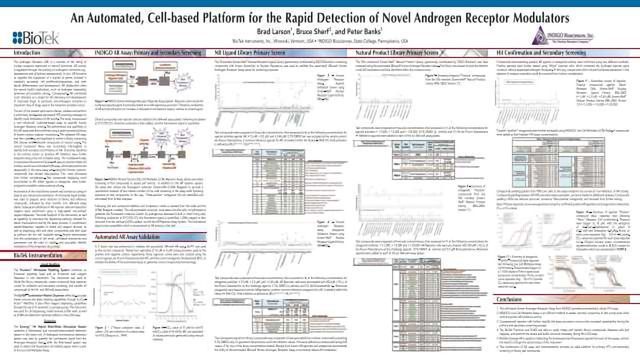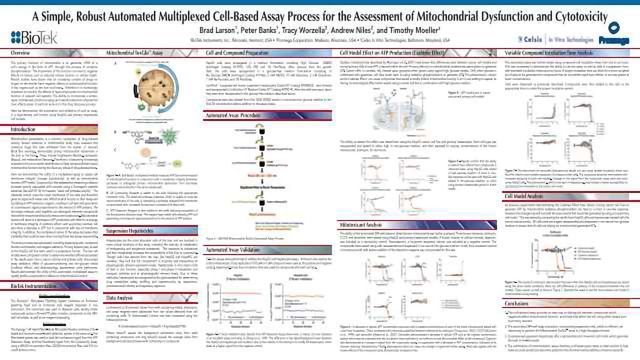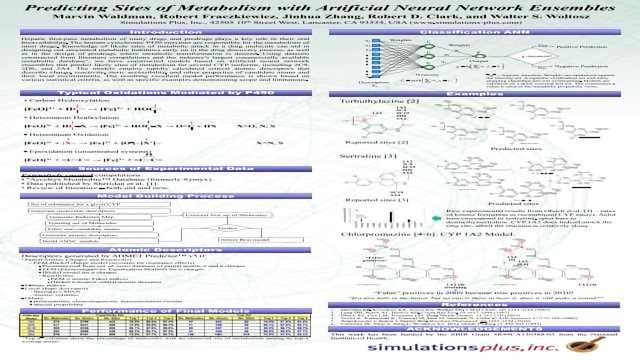Latest Posters

Poster
Automation of a Novel Cell-Based ELISA for Cell Signaling Pathway Analysis
Monitoring and quantifying cell signaling pathways is critical for understanding the behavior of cell processes and many disease states. Monitoring and quantifying cell signaling pathways is critical for understanding the behavior of cell processes and many disease states.

Poster
Automation of a Generic Fluorescence Methyltransferase Activity Assay
Epigenetic processes are attracting considerable attention in drug discovery as their fundamental roles in controlling normal cell development and contributions to disease states become more clearly defined. This work combines a fluorescence-based assay with liquid handling and dispensing instrumentation and a multi-mode reader which can be used to monitor the biological activity of the histone methyltransferase (HMT) G9a, a model system.

Poster
Validation of an Automated Cell-Based Bioluminescent TNFa Blocker Bioassay
TNFa blocker biopharmaceuticals represent an important and successful class of protein drugs used in the treatment of several autoimmune diseases. Bioassays are indispensible tools in biopharmaceutical drug development and commercialization that are used to quantify biological activity and stability of drugs or drug candidates. The automation of these assays can serve to create an accurate, robust process which can allow the researcher to perform other more important functions.

Poster
Automated Solutions for Cellular Screening and Characterization of Therapeutic Antibodies for Antibody-Dependent Cellular Cytotoxicity Utility
Since the end of the 1990’s, the pharmaceutical industry has seen an increased interest in biologics, especially in the therapeutic areas of oncology and inflammation. Here we present the automation of two assays for the characterization and selection of potent antibody drug candidates. Both assays rely on HTRF® detection. The first assay quantifies the binding affinity of antibodies to their target antigen, on live cells.

Poster
An Automated, Cell-based Platform for the Rapid Detection of Novel Androgen Receptor Modulators
The Androgen Receptor (AR) is a member of the family of nuclear receptors responsive to steroid hormones. This poster aims to devise, validate and perform a preliminary automated HTS screening campaign to identify novel modulators of AR activity.

Poster
A Simple, Robust Automated Multiplexed Cell-Based Assay Process for the Assessment of Mitochondrial Dysfunction and Cytotoxicity
Recent studies have shown that an increasing number of drugs no longer on the market have negative effects on mitochondrial function in key organs such as the liver and heart. Therefore it is increasingly important to monitor the effects of lead compounds on mitochondrial function in relevant cell systems. The ability to incorporate a simple, rapid, multiplexed, predictive assay can make the detection of potential toxic effects easier to perform early on in the drug discovery process.

Poster
High Content Analysis of Neural Stem Cell Expansion and Differentiation
Automated assay methods for monitoring neural stem cell expansion and differentiation using stem cell derived neural cell lines and high content imaging systems have been described.

Poster
Modeling Disposition of Sotalol following Intravenous and Oral Administration in Healthy Adult Subjects
Sotalol is a non specific adrenergic beta-antagonist that is used in the treatment of life-threatening arrhythmia. Its absorption, distribution and systemic PK or, collectively, ‘disposition’ was modeled and simulated using GastroPlus™ v7.0. Biopharmaceutical properties were obtained from in silico predictions and in vitro measurements.

Poster
Predicting hERG Potassium Channel Affinity with Artificial Neural Network Ensembles
Modeling hERG inhibition has gained significant popularity since 2005, when the FDA recognized the correlation between hERG inhibition and a prolonged QT interval by issuing guidance for the evaluation of new non-antiarrythmic drugs against the hERG channel.Long QT syndrome or LQTS is a risk factor for ventricular tachyarrhythmias and sudden death.

Poster
Predicting Sites of Metabolism with Artificial Neural Network Ensembles
Hepatic first-pass metabolism of many drugs and pro drugs plays a key role in their oral bioavailability. The human cytochrome P450 enzymes are responsible for the metabolism of most drugs. Knowledge of likely sites of metabolic attack in a drug molecule can aid in designing out unwanted metabolic liabilities early on in the drug discovery process, as well as in the design of pro drugs where metabolic transformation is desired.
Advertisement

